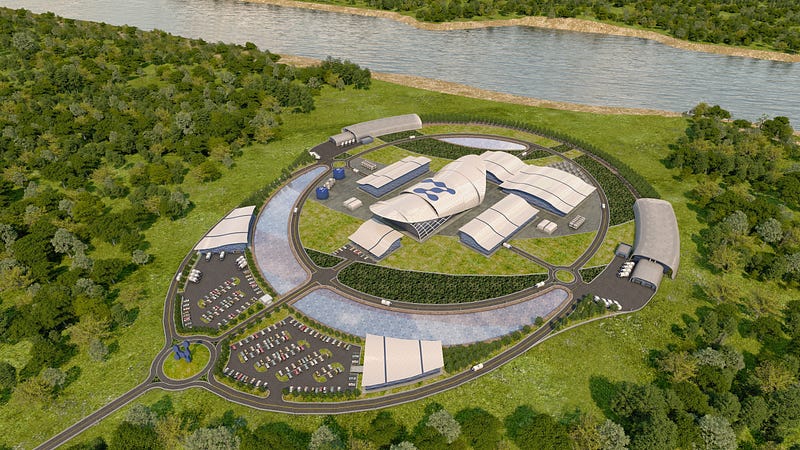The Future of Nuclear Power: Are NuScale's SMRs the Answer?
Written on
Chapter 1: Introduction to Small Modular Reactors
Small Modular Reactors (SMRs) are often touted as the next generation of nuclear power, combining a compact design with the potential for cost efficiency, rapid construction, and enhanced safety. These reactors are also noted for their remarkably low carbon emissions, making them an attractive option in the fight against climate change. However, the transition from theory to practice reveals significant challenges. Despite the excitement, developing an SMR that meets all the anticipated benefits while complying with stringent government regulations is a formidable task. Recently, NuScale’s SMR received the first-ever approval from the U.S. government, paving the way for a new era of SMRs. But what hurdles remain?
Before diving deeper into NuScale’s innovation, let’s clarify what SMRs are and how they differ from traditional reactors.
Section 1.1: Understanding Traditional Nuclear Reactors
Standard Light Water Reactor (LWR) nuclear plants consist of several large reactors. These massive structures require extensive on-site construction with exceptional precision, which not only inflates costs but also prolongs the building timeline. Additionally, each reactor contains a significant amount of nuclear fuel, posing a potential risk for catastrophic failures stemming from human or technical errors, although the likelihood of such incidents is minuscule.
In contrast, SMRs utilize multiple smaller reactors working in unison. Their reduced size allows for off-site manufacturing in specialized facilities, which can significantly shorten construction periods. The economies of scale achieved through mass production also lower costs compared to LWRs. Each reactor functions as an independent unit with much less nuclear fuel, mitigating the impact of any potential incidents.
While downsizing existing reactor designs to create SMRs may seem straightforward, it’s essential to understand that such modifications would lead to malfunctions. Therefore, SMRs demand innovative designs, unique configurations, and sometimes specific types of high-enrichment nuclear fuel for proper operation.
Fortunately, NuScale has developed a design that closely mirrors contemporary LWR reactors. This design not only simplifies training for personnel with LWR experience but also reduces regulatory barriers since no groundbreaking technology requiring extensive testing is involved.

Section 1.2: The NuScale Reactor Design
NuScale’s reactor resembles a tower structure. At its base, nuclear fuel undergoes controlled fission, heating water until it boils and converts to steam. The increasing pressure forces the steam into the upper section, where it drives a turbine to generate electricity. The steam then cools at the top, condenses back into water, and flows down to the base, ready to be reheated. The entire reactor is submerged in a tank of cold water, and both the vat and the reactors are housed in a robust structure designed to contain any potential nuclear contaminants.
Overall, this design is remarkably efficient. It occupies just 1% of the size of a conventional reactor, uses standard 5% enrichment nuclear fuel, and only requires refueling every two years, which is typical for nuclear reactors. All necessary safety features are incorporated into the design.
It’s no surprise that on January 1, 2023, the U.S. Nuclear Regulatory Commission (NRC) granted approval for NuScale’s VOYGR-6 SMR plant design. This modular design includes six SMRs, producing a total output of 462 MWe, which is about half the average output of a traditional nuclear facility. NuScale also has plans for a VOYGR-12, doubling the number of reactors and expected output, which is likely to gain approval soon due to its similar design.
Moreover, the Department of Energy is collaborating with Utah Associated Municipal Power Systems and the Carbon Free Power Project to establish a NuScale VOYGR-6 plant at Idaho National Laboratory. Following this NRC approval, construction will soon commence, allowing for the practical benefits of SMRs to be showcased.
Chapter 2: Challenges and Opportunities
Video Description: This video discusses how NuScale's Small Modular Reactor (SMR) could change the energy landscape, highlighting the technology's advantages and challenges.
Despite the optimistic outlook, the situation is not entirely straightforward. While NuScale is poised to demonstrate the speed, flexibility, and safety of SMRs, their design still faces criticism. Initially, NuScale estimated that the cost per MWh for a VOYGR plant would be around $50, making it a viable competitor to solar and wind power. However, as development progressed, costs have surged, with projections now hovering around $89 per MWh.
This dramatic cost increase undermines one of the primary appeals of SMRs: the promise of lower energy costs. The excitement surrounding SMRs is largely fueled by their potential to rejuvenate nuclear power through affordability. However, if they end up costing as much as traditional LWRs, the incentive to adopt them diminishes.
But does this mean the end of the SMR vision? Not necessarily. As discussed in my article on the Holtec SMR-160, a significant obstacle for nuclear power remains the high initial costs and protracted construction timelines associated with new plants. Despite having lower carbon emissions than solar, the development of new nuclear reactors has lagged. While NuScale may not reduce the price of nuclear energy, their approach could address these critical issues, enabling nuclear energy to expand and fulfill its potential as a key player in climate change mitigation.
In conclusion, keep an eye on the developments surrounding NuScale's SMR. While not without flaws, it has the potential to revolutionize nuclear energy and contribute significantly to environmental sustainability.
Video Description: This video examines the implications of NuScale Power's SMR project cancellation and its impact on the U.S. nuclear sector.